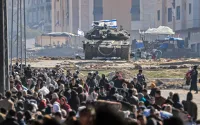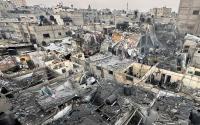www.latimes.com/news/printedition/asection/la-na-klan23-2008nov23,0,4051889.story
by Howard Witt
23 November 2008
Bogalusa, Louisiana - Barely three weeks since America elected its first black president, noose hangings, racist graffiti and death threats have struck dozens of towns across the country.More than 200 such incidents -- including cross burnings, assassination betting pools and effigies of President-elect Barack Obama -- have been reported, according to law enforcement authorities and the Southern Poverty Law Center, which monitors hate groups.
Racist websites have been boasting that their servers have been crashing because of an exponential increase in traffic.
And America's most potent symbol of racial hatred, the Ku Klux Klan, is reasserting itself in a spate of recent violence, after decades of disorganization and obscurity.
Nearly two weeks ago, the leader of a cell based in Bogalusa, La. -- a backwoods town once known as the Klan capital -- was charged with second-degree murder in the shooting of a woman who allegedly sought to become a member but then changed her mind.
Late last month, two men with ties to a notoriously violent Klan chapter in Kentucky were charged in a bizarre plot to kill 88 black students and then decapitate an additional 14 students -- and then assassinate Obama by shooting him from a speeding car while wearing white tuxedos and top hats.
"We've seen everything from cross burnings on lawns of interracial couples to effigies of Obama hanging from nooses to unpleasant exchanges in schoolyards," said Mark Potok, director of the Intelligence Project at the Southern Poverty Law Center, based in Montgomery, Ala. "I think we're in a worrying situation right now, a perfect storm of conditions coming together that could easily favor the continued growth of these groups."
Experts attribute the racist activity to factors including the rapidly worsening economic crisis; trends indicating that within a generation whites will not comprise a U.S. majority; and the impending arrival of a black family in the White House.
The FBI is investigating whether the recent Klan-related incidents involve conspiracies. And the Secret Service is monitoring the racist activity "to try to stay ahead of any emerging threats," according to spokesman Darrin Blackford.
One white supremacist leader, describing himself as moderate, professes alarm.
"There is a tremendous backlash" to Obama's election, said Richard Barrett, the leader of the Nationalist Movement in Learned, Miss. "My focus is to try to keep it peaceful. But many people look at the flag of the Republic of New Africa that will be hoisted over the White House as an act of war."
The FBI has no hate-crime statistics yet for 2008.
But based on local media reports, some experts are calling the rise in hate incidents surprising and unprecedented.
"The rhetoric right now is just about out of control," said Brian Levin, director of Center for the Study of Hate and Extremism at Cal State San Bernardino. "When you get this depth of hatred, it usually is the smoke before the fire."
In the small Louisiana town of Angie, 58-year-old Judy Robinson put an Obama sign outside her home a few weeks before the Nov. 4 presidential election. The morning after Halloween, she awoke to find the words "KKK" and "white power" spray-painted around her yard.
"I thought all that KKK stuff was in the past," said Robinson, who is black. "But now I look at people and think, 'Could he be Klan?' Suddenly I'm feeling like my town is hostile territory."
Experts say modern Klan chapters remain isolated and small, with perhaps 6,000 members nationwide -- a shadow of the group's membership of 4 million in the early 1900s.
Bogalusa, a lumber and paper mill town of about 13,000, is just down the road from Angie.
In the 1960s, historians say, the Ku Klux Klan so dominated Bogalusa's commerce, politics and law enforcement that the group once held a public meeting to debate which black church to burn down next.
Several Bogalusa Klan members were long suspected of shooting two black sheriff's deputies in a 1965 ambush, killing one. No one was ever brought to trial.
"To this day, most white people in Bogalusa know who the killers were, and they were never brought to justice," said Lance Hill, a Tulane University law professor and Klan expert.
That past now seems less distant.
On Nov. 10, local law enforcement authorities arrested Raymond "Chuck" Foster, 44, the leader of a Bogalusa Klan chapter called the Sons of Dixie, and seven other Klan members in connection with the shooting death of a Tulsa, Okla., woman who went to the group's remote campsite in St. Tammany Parish for an initiation ceremony.
Authorities say Foster shot the woman when she tried to change her mind about joining the group. He has been charged with second-degree murder; the other Klan members, including Foster's 20-year-old son, have been charged with obstruction of justice.
City officials say they had no idea that Bogalusa has Klan cells.
"I've been here 13 years, and this was a complete surprise to me that there was Klan here," said Police Chief Jerry Agnew.
Yet members of the town's black community say they have been reporting Klan sightings to the police for more than a year. About 40% of residents are black.
In October 2007, residents of one black neighborhood reported white-hooded Klan members riding horses through the streets.
And in March, Klan members openly handed out fliers advertising the second annual Sons of Dixie Knights of the Ku Klux Klan Craw Fish Boil -- held at the house on Louisiana Avenue that Foster was renting from a Bogalusa deputy sheriff.
"The city leaders want to make it look like this is just some small fringe group," said former City Councilman Marvin Austin, 61, who once belonged to the Deacons for Defense, a black group that formed in the 1960s to defend black residents from the Klan.
"But the Klan still has a lot of sympathizers here."






